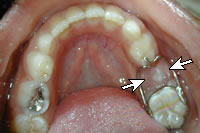In dentistry, precision attachments are the functional mechanical parts of the removable partial denture made of plastic, metal or a combination of both. Precision attachment partial dentures can be used to restore arches where there are not enough teeth for fixed bridgework. They consist of two parts referred as the ‘male’ part that is fixed to a crown inside the patient’s mouth and a ‘female’ part which holds the partial denture. The male is machined by the manufacturer to fit the female with such precision that any male out of the box will fit any female with an exact degree of accuracy. All of the precision attachments in a partial denture are positioned so that they are exactly parallel to each other. The patient can insert and remove the partial dentures and the aim of the precision attachment is to give the patient maximum comfort and ease while wearing, inserting or removing. Continue reading
Category Archives: Denture
Types of Mandibular Major Connectors Part 2
LINGUAL BAR WITH CONTINUOUS BAR INDIRECT RETAINER
SYNONYMS: KENNEDY BAR, SPLIT LINGUAL BAR, DOUBLE LINGUAL BAR
Indications:
1. Situations where the major connector must contact the natural teeth to provide bracing and indirect retention and there are open cervical embrasures which contraindicate the use of a lingual plate. There must be adequate space for the lingual bar portion of the major connector. Continue reading
Types of Mandibular Major Connectors Part 1
The MAJOR CONNECTOR is that part of a remvable partial denture (RPD) that joins the component parts on one side of the arch to those on the opposite side. It is the unit of the RPD to which all other parts are directly or indirectly attached. Continue reading
Types of Maxillary Major Connectors
The first requirement of a major connector is rigidity. This allows stresses that are applied to the partial denture to be distributed effectively over the entire supporting area, including the teeth, underlying, bone and soft tissue. Other components of a partial prosthesis can only be effective if the major connector is rigid. Flexibility allows forces to be concentrated on individual teeth or edentulous ridges causing damage to those areas. Continue reading
Dentures making me gag
One reason some people give for not wearing their new denture is because their denture causes them to gag.
Before you discard your denture or dentures forever, you need to discover the real cause for your gag reflex and what your options are. Continue reading
Trial denture try in Part 3
Denture base extension:
The lower trial denture extension should be tested with the patient mouth is opened no more than half opened position. To allow the surrounding musculature is in an acceptable state of relaxation.
• Labial and buccal extensions are checked as for the upper trial denture. Continue reading
Trial denture try in Part 2
Denture base extension:
a) The labial and buccal extension:
- If marked overextension of the flanges, will stretch the sulcus tissues when denture inserted, leading to elastic recoil result in dislodgment of the denture, immediate denture displacement after its seating.
Continue reading
Trial denture try in Part 1
Definition:
Preliminary insertion of complete denture wax up (trial denture) to determine the fit, esthetics, maxillomandibular relations —–etc.
Continue reading
Space Maintenance in Children
Â
Â
Space Maintainer is a fixed or removable appliance designed to preserve the space created by the premature loss of a tooth (can be primary or permanent tooth). Fixed Space Maintainer is not intended to be removed by the patient whereas Removable Space Maintainer is designed for easy removal for cleansing and/or adjustment. Continue reading
How to Remove Dentures That Have Been Fixed in With Denture Adhesive
Getting used to dentures may seem daunting at first, but after a little practice, using and caring for your dentures will seem like second nature. Whether you use adhesives to hold your upper, lower, or both sets of dentures in place is purely a personal choice. If you do use denture adhesives, learning to remove your dentures is one of the denture-wearing skills you’ll quickly master with just a little practice. Within a week you’ll be a seasoned pro. Continue reading
